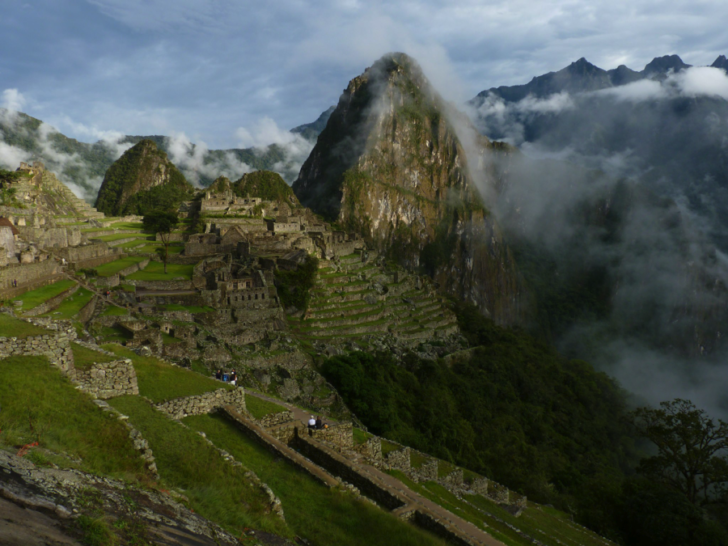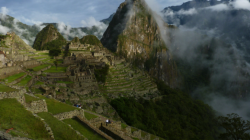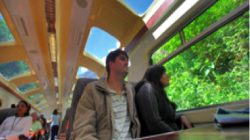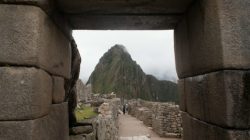Check out Part I: Advance Preparation and Part II: Getting There
Buses for Machu Picchu begin departing as early as 5AM (and for this reason, some restaurants begin serving breakfast as early as 4:30). Taking the first bus is unnecessary: the trip is about twenty minutes and the gates don’t open until 6AM. By getting on the ~5:30 buses, we were able to get to the gates just before the park opening. There were a good hundred people ahead of us, but the line moves fast. Since most people made a beeline straight up to the guardhouse (number 16 on this map from the official website), I was able to take a few quick, mostly tourist-free snaps from the western edge of the terraces. The way to do this is simple: just head straight from the entrance and don’t follow the trail uphill. These early pictures were arguably my best:
For the first two hours or so, traffic at the ruins is relatively light (note that this coincides with the period before the first train arrives from the Sacred Valley). Despite this opportunity for uncrowded exploration, we headed straight for Huayna (or Wayna) Picchu, which is the mist-covered mountain you see on the right side of the photo. In order to climb Huayna Picchu, you must buy the tickets in advance along with your primary admission. These tickets cannot be purchased separately, so if decide against buying admission to the mountain and change your mind later, you will have to buy an entirely new set of tickets. The combined tickets cost an extra 30 soles (~$12 dollars), but we found the purchase entirely worthwhile.
Presumably for safety reasons, access to the mountain is restricted. Prospective visitors to Huayna Picchu can enter during two three-hour periods: one beginning at 7AM and another beginning at 10AM. Each time window accommodates 200 visitors. You have the option of climbing the rather steep but mostly non-treacherous trail to the summit of Huayna Picchu or the shorter trail to the summit of Una Picchu (the smaller mountain to the left in the picture). Unless you decide against taking some time to explore the ruins at the Huayna Picchu summit, you’ll find it difficult to visit both peaks in the three-hour window.
Given our time constraints, we decided to bag the larger summit. About fifty people were massed around the Huayna Picchu entrance when the gate opened just before 7AM, but no lines formed. Because we were reading the map by the entrance at the time they started admitting people, we were the fifth and sixth visitors to enter. Thanks to our fortunate timing and slow-but-steady approach, we were the first to reach the summit. This was a major advantage for many reasons, not the least of which was unimpeded travel.
The trail to Huayna Picchu splits into an especially narrow and steep circle route one you reach the ruins below the summit. I strongly recommend following the signs that point you rightwards (counter-clockwise) along the route. Keep in mind that you will need to pass through a narrow tunnel on this path (for this reason, guidebooks call this the “tunnel route”). This may require crawling, depending on how tall you are. If you are claustrophobic, you can ascend the other way, but watch out for people descending. On the backside of the mountain, just below the summit, is the beginning of the long trail to the Gran Caverna and the Temple of the Moon. We passed on this long hike, although it does sound rewarding.
Returning from Huayna Picchu, we found that the main ruins were packed. Trains bearing tour groups from Cuzco had begun to arrive and the premier sites (the Intihuatana, the Temples of the Sun and the Three Windows) were completely swamped. We took this opportunity to explore the less impressive ruins on the east side. With some more foresight, I might have considered taking a break at this point.
Peak hours at Machu Picchu appear to start around 10AM and continue until the early afternoon. High visitation hours also happen to overlap with the hottest parts of the day. Once the peak hours are over, the ruins are practically deserted. Given our early start, we could have afforded a long break and still had plenty of time to explore the rest of the site later. If you are interested in conserving energy and have some way of passing the time during your break, I recommend this approach. However, if you have an early return to Cuzco or Ollantaytambo (before 5PM) then you will just need to bear it.
If you want to get a general sense of how to plan your time at Machu Picchu, consider this: Through the course of about eight hours of active exploration, we were able to visit every major site in the ruins. That includes our hike up Wayna Picchu and a minor hike to the Inca drawbridge. We were able to do all of this at a very leisurely pace with plenty of time for photographs. With a little more time and effort, we probably could have seen the Temple of the Moon or Intipunku (but probably not both).
As for provisions, we had brought two liters of water and two box lunches (we ate these at the hotel snack bar outside of the ruins). Some guidebooks will mention that food and drink is prohibited inside the Machu Picchu gates, but plenty of people were drinking water, so it does not appear that this prohibition is enforced (if it exists). In retrospect, I would have brought an extra liter of water. We also brought plenty of sunscreen but still managed to get burned. Consider the altitude and apply generously. Did I mention that we had a copy of the Machu Picchu Guidebook on hand? Having thorough and accurate information about the ruins on hand really enhanced our experience there.
GETTING HOME
Although buses depart less frequently in the afternoon than they arrive in the morning, we only had to wait about ten minutes for our bus to take off. We had over two hours to descend from Machu Picchu, buy some snacks, pick up luggage from our hotel, and arrive at the train station. This was more than enough time, especially since we had picked up our train tickets the day before. The lines at the station were extremely long, so keep this option in mind if you are spending the previous night in Aguas Calientes.
Another thing to remember is that there are two Peru Rail offices, one of which is only for locals. Be sure to have your tickets printed at the Peru Rail station in the station itself. Anyways, we took the Expedition train for our return trip due to the convenient time, and this proved to be a mistake, for reasons that I mentioned in my previous post. However, after a day where virtually everything worked out, I have few complaints.
NOTES AND ERRATA
You might have noticed that I linked a lot of information in my posts. Mostly this is to give credit where it is due. However, another part of me wants to emphasize that it’s important to stay updated with multiple sources. The rules, the regulations, and even the names for things at Machu Picchu seem to change every month, so take this information for what it’s worth. My knowledge of this place will probably never be more current than the timestamp on this post. However, if you would like to ask further questions in the comments, feel free to fire away.






